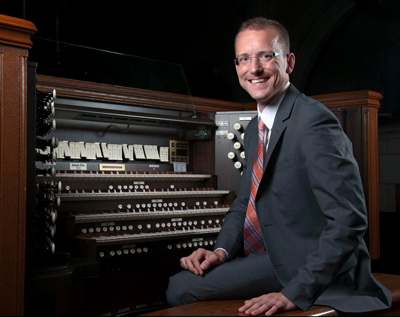by Timothy Robson

The concert was divided into segments, with instructions in the printed leaflet requesting no applause until the end of each section. Lane’s spoken notes were informative and concise. The whole concert was just the right length, about 75 minutes, burnishing the adage of “always leave them wanting more.”
The first segment consisted of Baroque works, first Dieterich Buxtehude’s Praeludium in g, BuxWV 149, featuring manual flourishes and pedal ostinato alternating with more sustained fugal passages that were vocal in character. Lane used unusual combinations of registrations to show off the clear, bright colors of the church’s Holtkamp organ. Probably every organist in the audience (of which there were many) was familiar with Buxtehude’s chorale prelude Nun bitten wir den Heiligen Geist, BuxWV 208. Though it’s often regarded as a student piece, Lane treated it with historically informed flair, flexibility of phrasing, and meditative serenity.
Johann Sebastian Bach’s Prelude and Fugue in e, BWV 548 (“The Wedge”) closed the first segment. Lane chose sensible, steady tempos resulting in great clarity of playing in the relatively dry acoustics of the church. Aside from some noticeable slips, it was a solid performance.
The second segment included modern pieces by Scottish composer James MacMillan and Americans Dan Locklair and Nico Muhly. MacMillan’s Offertorium was composed and performed in 1986 for the wedding of friends. The manuscript recently came to light as the couple celebrated their silver wedding anniversary. Unlike some of MacMillan’s works, Offertorium is very melodic, and harmonically conservative. Its use of ornamentation lends it a quintessential Scottish sound. Lane gave the attractive work a convincing reading.
Dan Locklair’s 1988 suite Rubrics and the individual titles of its movements are derived from the instructions found in liturgical prayer books. During the exchange of the “Peace” during the Mass, congregants greet each other before the solemnity of the Eucharist. This inspired Locklair to compose a lyrical melody over soft, but flowing accompaniment of considerable rhythmic complexity with double pedaling. The second part of the piece adds a countermelody and mild dissonances to the original tune. The movement ends peacefully, which provided an effective moment of calm in the program.
Born in 1981, Nico Muhly has become one of the best-known composers of his generation, with commissions by the Metropolitan Opera and many other performing arts organizations. His Prelude on ‘Lasst uns erfreuen’ (a familiar tune full of Alleluias) takes a counterintuitive approach to the melody — introspective and quirky, with segments of minimalism, rather than a grand, full-organ presentation. The tune is often lurking within the texture. Although seemingly straightforward, the piece is complicated, with unexpected twists and turns. Christian Lane had it all well under control. Both Muhly’s and MacMillan’s pieces would be worth the effort for organists interested in exploring relatively conservative new repertoire.
Canadian Denis Bédard’s Variations on “The Old Hundredth” is a confection in the grand style, the tune tinged with jazz chords and other unpredictable influences. Even Olivier Messiaen’s harmonies make a brief appearance before a big French toccata, with the tune in the pedal. Though it isn’t a timeless masterpiece, Lane made it entertaining.
The final segment began with the Toccata prima from Georg Muffat’s Apparatus music-organisticus of 1690. Lane told the audience that the toccata was in the avant-garde style of its time, its improvisatory flourishes laden with rhetorical emotion.
Felix Mendelssohn’s 1844 Theme and Variations in D seems unjustly neglected. It is well-crafted and tuneful — an attractive work. The variations are nowhere as extravagant as Bédard’s, but they brought melodic relief and showed off the soft flutes on the organ.
Swiss organist-composer Guy Bovet’s Hamburger Totentanz takes the idea of the “dance of death” to a satirical extreme, with its steady, triple-meter rhythms, and pervasive repetition with slight variations. Along the way he slyly quotes several other works, including the “Barcarolle” from Offenbach’s Les contes d’Hoffmann and, eventually, the clichéd opening notes from Beethoven’s Für Elise, before building to a huge climax. Although we were bidden not to do so, it was hard not to clap after this performance.
Lane closed his program with Carson Cooman’s Gloucester Estampie, identified as Cooman’s Op. 862 — quite a prolific achievement for a composer born in 1982! The work’s title is a nod to the Massachusetts home of C.B. Fisk, the organbuilders who recently installed a new instrument in Harvard’s Memorial Church, where Cooman is on the staff. The work is patterned on a medieval dance form. After a loud introduction, the medieval-like tune is developed and varied to a full organ climax, but the piece really needed a larger room and more ambience to make its full effect.
Christian Lane returned for a brief, spiritually sensitive encore, J.S. Bach’s chorale prelude on Liebster Jesu, wir sind hier, BWV 731.
Published on ClevelandClassical.com April 18, 2016.
Click here for a printable copy of this article



